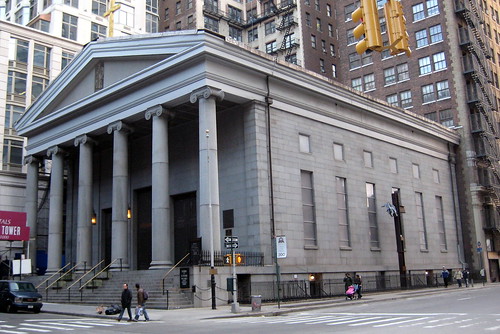
The expected contrast one might legitimately make is between Trinity, the always comparatively opulent church at Broadway and Wall Street and St. Paul's Chapel at Broadway and Fulton. The churches are at either end of a royal charter dating from the end of the eighteenth century. They originally enclosed the King's College campus, the institution that presently bears the name Columbia University but retains the crown as its crest.
St. Paul's was intended as Trinity's "chapel of ease," a country church corresponding to St. Martin-in-the-Fields, London. Indeed, it is of the same era: 1722-1726 being the dates of construction for St. Martin's, 1766 with the steeple added in 1796 for St. Paul's. St. Paul's was the church George Washington attended immediately following the conclusion of the Revolution in 1783 and after he became President in 1789. Like St. Martin's, London, which it resembles, it was a country church at the very fringe of the city, its front on Chapel, now Church Street, its back turned to Broadway.
Less obvious, but in certain ways more intriguing, is the relationship of St. Paul's and its Anglican tradition to St. Peter's, the first Roman Catholic congregation in New York. The first building on St. Peter's site at Barclay and Church Streets appeared in 1785. The date is important. The Treaty of Paris ending the Revolutionary War had just ended. Trinity Church was itself in the process of constructing its second building at Wall Street, the first having been destroyed in the great fire of 1776. The Trinity congregation was also intent on overcoming the Tory associations it had had during the British occupation of the city. It therefore gave a lease on the square of land at the fringe of its original land grant to the first Roman Catholic congregation in New York.
As a public relations move, it was brilliant. It quelled resistance to the reconstruction of Trinity and quickly established the Episcopal identity of the Trinity congregation as one distinct from the Anglican. Even so, it was only with the second St. Peter's building, constructed in 1836, that Roman Catholic St. Peter's moved architectually away from the appearance of a British chapel of ease. The present building is pure Greek Revival, a perfect Ionic temple, though its interior still recalls an eightenth-century English country church.
